Stocksbridge WwTW (2019)
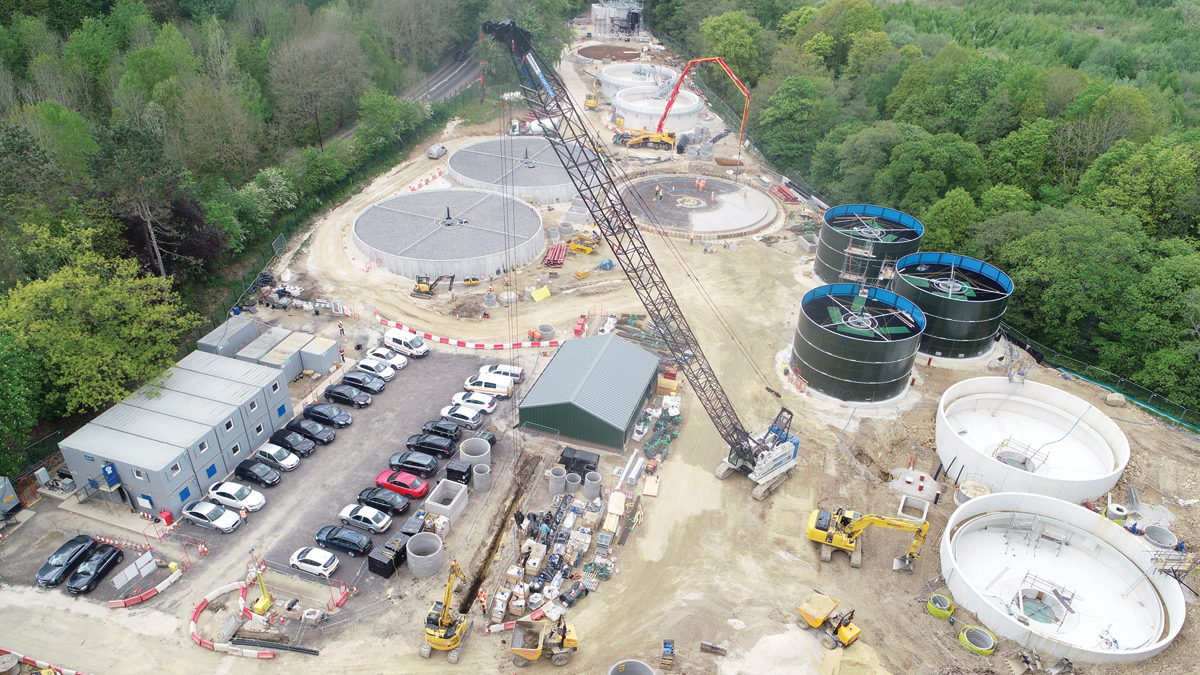
Aerial shot of the new works showing progress to date (May 2019) - Courtesy of MMB
Stocksbridge WwTW is located in the village of Deepcar on the outskirts of Stocksbridge, approximately 7km northwest of Sheffield city centre. It currently serves a population of 13,000, but this is expected to grow towards 15,000 by 2030. Major housing development is ongoing near the existing works, and as part of this Yorkshire Water reached an agreement with the housing developer to relocate the works 2km to the south. Relocating the works also allows for it to be suitably sized to serve the expected rise of the population equivalent, as well as ensuring compliance with discharge consents. Yorkshire Water Services appointed Mott MacDonald Bentley (MMB) to design and deliver the £15.65m scheme.
Existing works & terminal sewage pumping station
The existing works features an inlet works, 3 (No.) horizontal flow sedimentation tanks for primary treatment, 4 (No.) trickling filters, 2 (No.) upflow humus tanks, plus 2 (No.) horizontal flow sedimentation tanks for tertiary treatment. There are also 2 (No.) sludge holding tanks for exportation. These assets are to be decommissioned, and a new Terminal Sewage Pumping Station (TSPS) built to transfer incoming flows from this works to the new works for treatment.
The TSPS, constructed within the site boundary of the existing works, will consist of two wet wells adjacent to one another with an overflow connection between the two. The FFT wet well houses 3 (No.) 37kW variable speed pumps, running duty/assist/standby to pump a flow to full treatment of 87 l/s. The storm wet well features duty/standby 105kW fixed speed pumps, capable of pumping 179 l/s during a storm event. All pumps will be served by a 2-tonne lifting beam with an electric chain hoist and electric traverse for safe pump removal. Two new GRP kiosks will be installed, one containing an MCC to provide power and control, and one housing a sub-station.
Design options
During the early stages of the project, a number of design options were investigated as potential solutions. A 7m deep shaft was proposed at one stage, but this was determined not to be a cost-effective solution due to a high CAPEX cost. A dry well pumping station was also one of the options but was ruled out for similar reasons. A ground investigation determined that the existing works consists of a lot of sandstone bedrock, which would not have lent itself well to the shaft option. The chosen solution – two adjacent wet wells – allowed for a shallower excavation, improving ‘buildability’ whilst reducing cost.
Twin pipeline – Manchester Road
A new twin pipeline connects the two sites and will transfer flows from the TSPS to the new works. A 400mm OD polyethylene storm main runs parallel with a new 315mm OD polyethylene FFT main for 2km along the A6102 Manchester Road; a busy single carriageway. The twin mains continually rise for approximately 700m where there is then a break pressure chamber. Sewage at the TSPS will be pumped up to this break pressure chamber; the static head between the two being approximately 27m. From the break pressure chamber, the flow will then gravitate for the remaining 1300m down to the new works.
At the time of writing (May 2019) the installation of the twin pipeline is complete after a 9-month construction phase, though many challenges had to be overcome during that time.
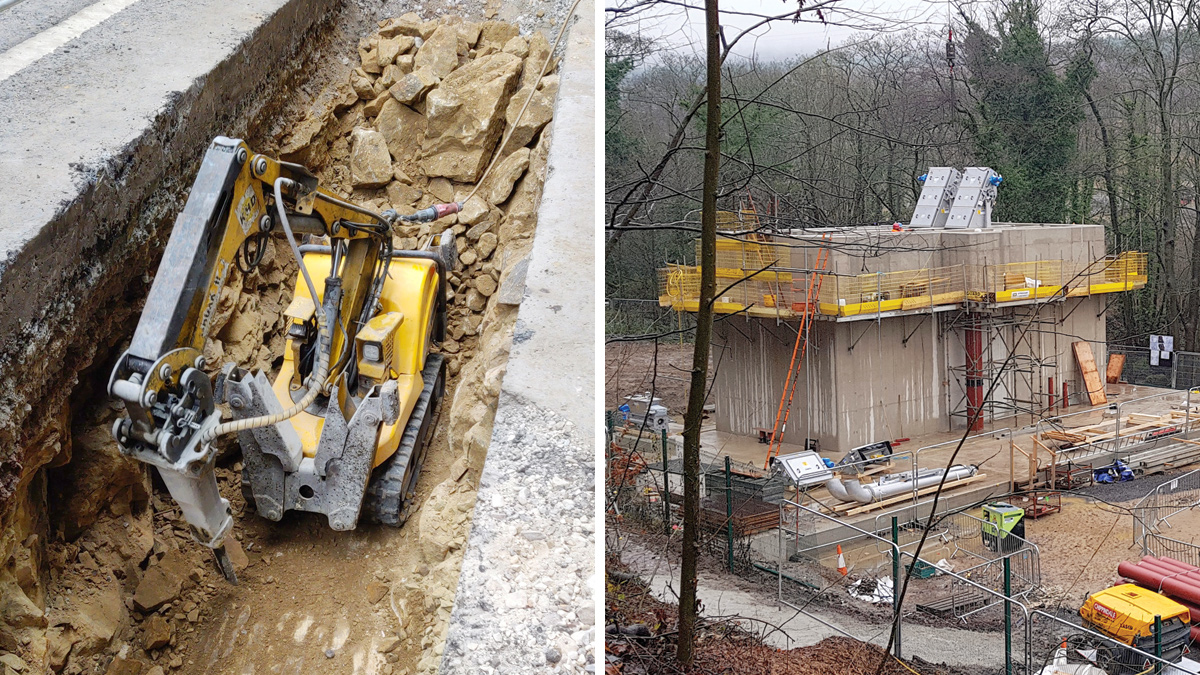
(left) Robotic breaker used during the mains installation and (right) new inlet works during installation of the fine screens (December 2018) – Courtesy of MMB
The carriageway is strewn with services (33” cast iron water main, 7bar IP gas main, service provider fibre optic cables), and the ground conditions were far from ideal. The team encountered significant rock that was particularly difficult to break through. To counter this, robotic breakers were used to efficiently tackle the rock, whilst simultaneously limiting exposure to potential HAVS. Swivelling quick-hitches were also used by the team during excavation, significantly reducing the time spent changing attachments.
A 6-week road closure during the school summer holidays allowed for a concentrated and sustained effort at furthering the installation of the 2km twin pipeline. Other than this 6-week period, the works had to be completed with a one-lane closure with traffic management. Positive engagement with the council and local community, including schools and nearby landowners, helped ensure this period of the construction ran as smoothly as possible.
New works (Stocksbridge STW No. 2)
The new works is situated on land that was once a garden centre and fisheries, and neighbours Ewden WTW and More Hall Reservoir. The site is narrow and compact, and as such it was anticipated that this would be challenging from a logistical and construction sequencing standpoint.
The first stage of the process at the new works consists of preliminary treatment, by way of an elevated inlet works with duty/standby fine screens and a vortex grit removal unit. There are then 2 (No.) radial upflow tanks, 15.5m in diameter, for primary treatment. Each tank is fitted with a half bridge scraper for sludge and scum removal.
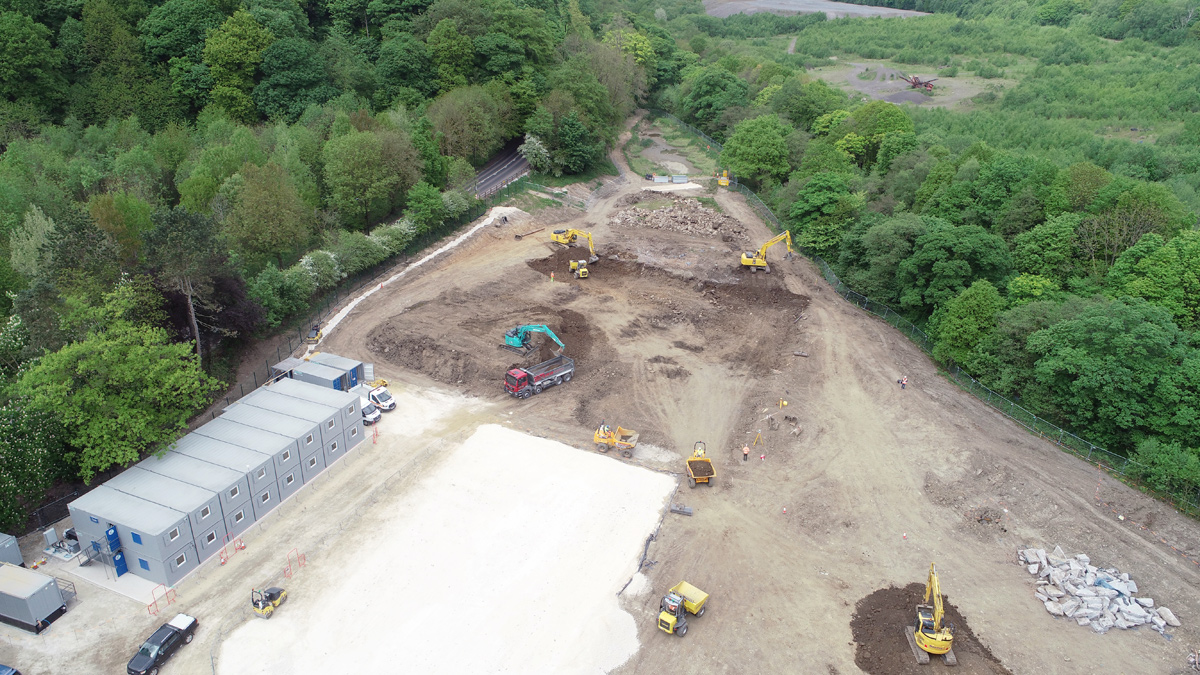
Site clearance at the new works (May 2018) – Courtesy of MMB
Secondary treatment consists of 7 (No.) trickling filters, plus 2 (No.) radial upflow tanks, 16.7m in diameter and fitted with half bridge scrapers, for humus settlement. Four of the trickling filters contain mineral media from Bagnall Construction Ltd, whilst the other three contain plastic media from ENEXIO 2H Water Technologies, with a 50:50 flow split between the two sets of filters.
The site will also feature two storm tanks providing 1027m3 of storage between them for storm events. The new works is designed to achieve 70mg/l suspended solids, a BOD of 25mg/l and 5mg/l ammoniacal nitrogen.
Sludge is to be removed from the primary settlement tanks via duty/standby ram pumps, which will transfer it to 2 (No.) sludge storage tanks, to then be removed via a tanker at a sludge exportation point. Sludge produced by the humus settlement tanks for removal from the process by air lift blowers to a chamber alongside the tanks. It will then gravitate towards a site drainage pumping station to which it will then re-enter the process upstream of the primary settlement tanks.
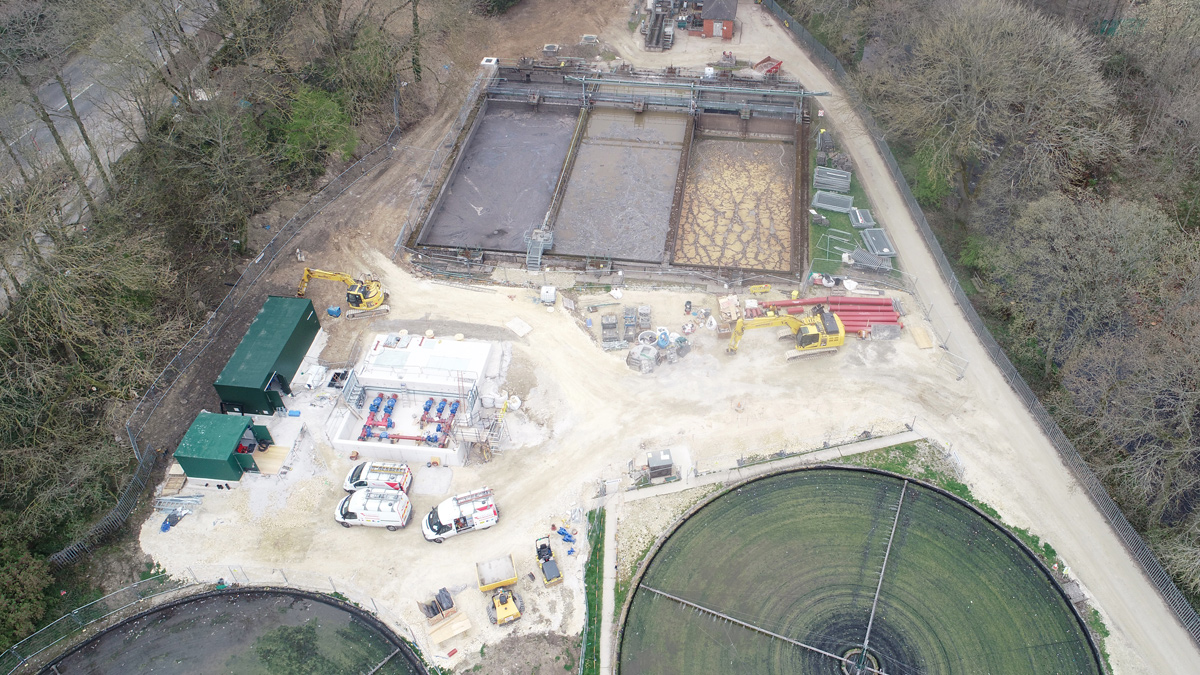
New TSPS at the existing works, shown between the existing primary tanks and trickling filters (April 2019) – Courtesy of MMB
SIte clearance
Site clearance began in early 2018 to enable the construction to commence. Because of the site constraints, it was essential that sequencing of the construction works was thoroughly planned to allow for an efficient construction period with minimal unforeseen delays. Collaborative planning has been at the forefront of the project, from its infancy and throughout construction. Regular CLIP (Construction Lean Improvement Programme) meetings have been held to establish a sequence of events that everybody can work towards, to allow the design and construction to progress cohesively. The design team have been based on site from the early stages of construction to bridge the gap between design and build wherever possible, and to provide immediate support to the site team when issues have arisen.
A close working relationship with Yorkshire Water, and early engagement with sub-contractors has been particularly beneficial to all parties, and they too have been involved in the collaborative planning sessions. By doing so, it has seen successful implementation of sub-contract works into the programme allowing any potential blockers to be foreseen, be it access to certain areas, availability of plant, enabling works required etc. Mitigation could then be taken to reduce any impact to the overall programme.
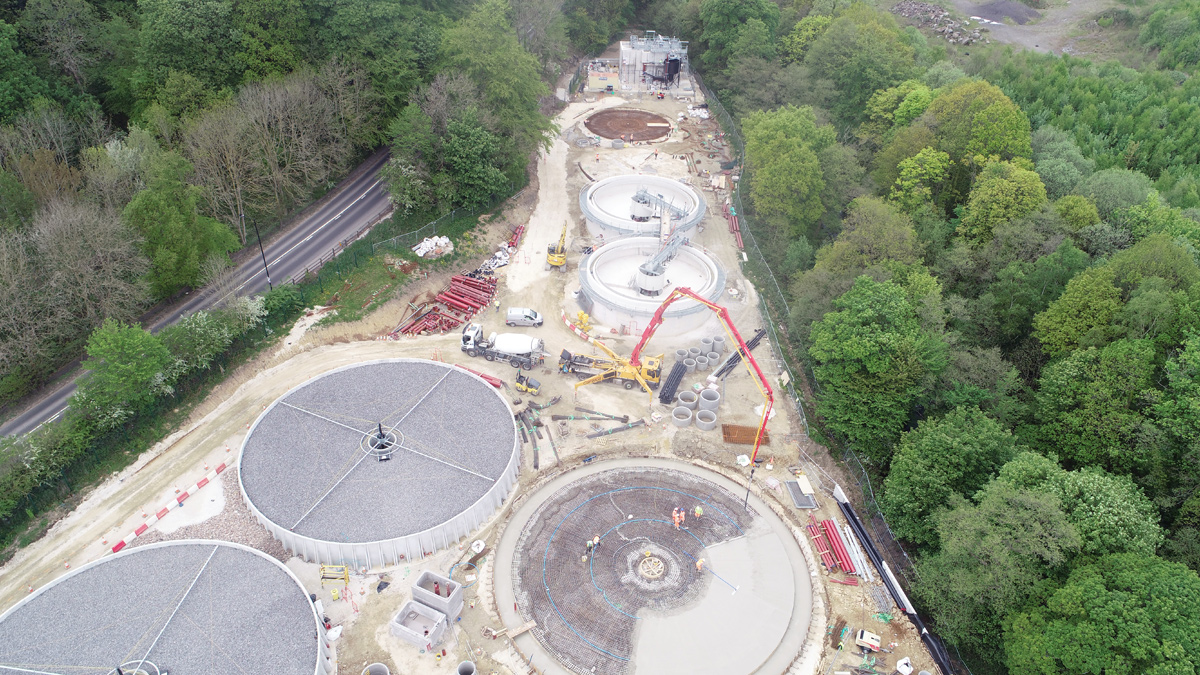
Concrete pour for one of the mineral media filter bases in progress (May 2019) – Courtesy of MMB
Progress to date – May 2019
Works at the TSPS are nearing completion, with power now established to the MCC and dry commissioning activities due to take place. The connection into the existing works’ inlet has now been made.
Construction is progressing quickly at the new works to enable commissioning to begin in the summer. Mechanical and electrical installation at the inlet works is virtually complete, with only the small bore washwater pipework yet to be fully completed.
Stocksbridge STW – Supply chain
- Principal designer & contractor: Mott MacDonald Bentley (MMB)
- Electrical installation: Circle Control & Design Systems
- Concrete construction: Bell Formwork & Civil Engineering
- Epoxy coated steel tanks: Balmoral Industrial Tanks Ltd
- Precast concrete units: Naylor Concrete Products Ltd
- Fine screens & wash compactors: Huber Technology
- Vortex grit removal & filter arms: Tuke & Bell Ltd
- Half bridge scrapers: DD Engineering Ltd
- Access metalwork: Galliford Try
- MCCs & software: Total Automation & Power (TAP)
- Mineral media & filter floor tiles: Bagnall Construction Ltd
- Plastic media: ENEXIO 2H Water Technologies
- Submersible pumps: Xylem Water Solutions UK Ltd
- Washwater booster pumps: Grundfos
- Ram pumps: EMS Industries Ltd
- Valves: Industrial Valve
- Valves: AVK (Glenfield Invicta)
The half bridge scrapers on the primary settlement tanks have been installed, and the metalwork around the tanks is nearing completion. Two of the four mineral media filters are now equipped with distribution arms, whilst construction of the remaining two has been held back to leave sufficient space for access around site. The bases of these have been poured and with the filter walls consisting of precast concrete units, it will not be long before media is being placed inside them.
Distribution arms have also been installed within the plastic media filters, with the tanks for these being Epoxy-Coated Steel (ECS). The other ECS tanks (the storm tanks and the sludge holding tanks)are yet to be constructed, but thanks to the efficient jack building method utilised, installation of each tank will take a matter of days rather than weeks. Focus will soon switch to the mechanical installation of the various pumping stations around site whilst the access metalwork installation continues, before concluding the electrical install to enable wet commissioning to commence.
Commissioning
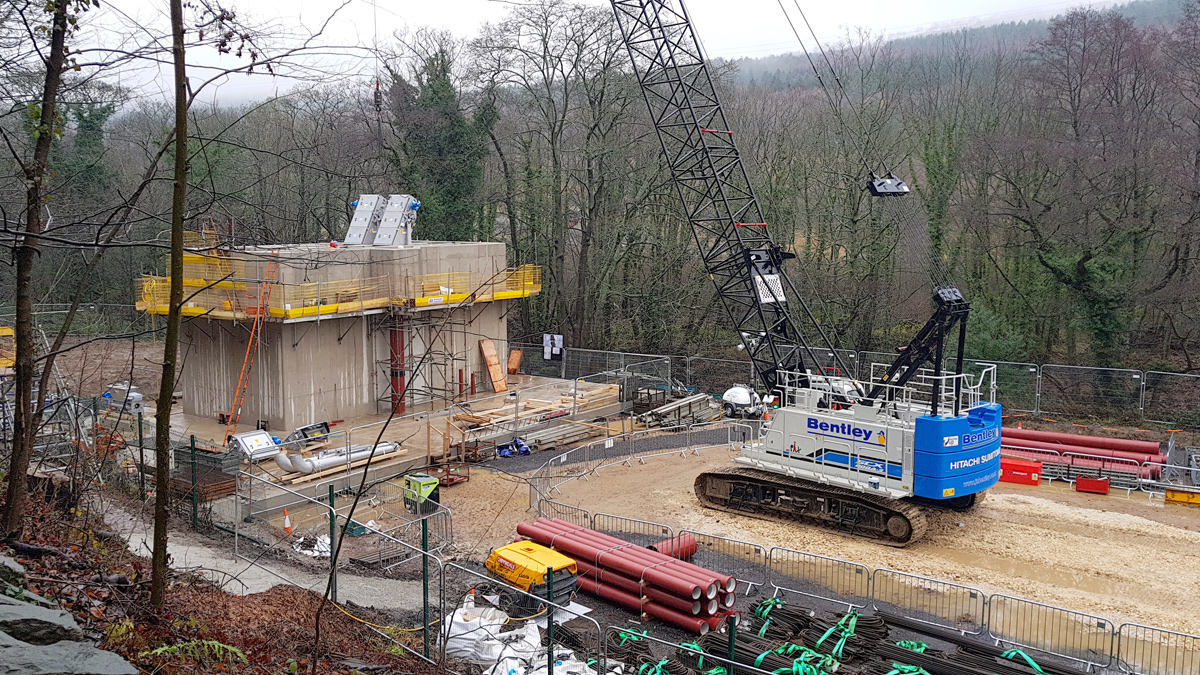
New inlet works during installation of the fine screens (December 2018) – Courtesy of MMB
Commissioning is due to begin in summer 2019 – scheduled for this period due to it being typically the best time for seeding filter beds. The existing works will continue to operate during the initial commissioning stages, with flows gradually being fed from the TSPS across to the new works. However, flows partially treated at the new works during commissioning will be returned to the existing works for full treatment to meet the discharge consent whilst the new works’ performance outputs are being established.
The implementation of the twin pipeline makes this possible; any storm events will still be catered for by the existing works during commissioning, therefore the storm main will be available for returning flows to the existing works.












